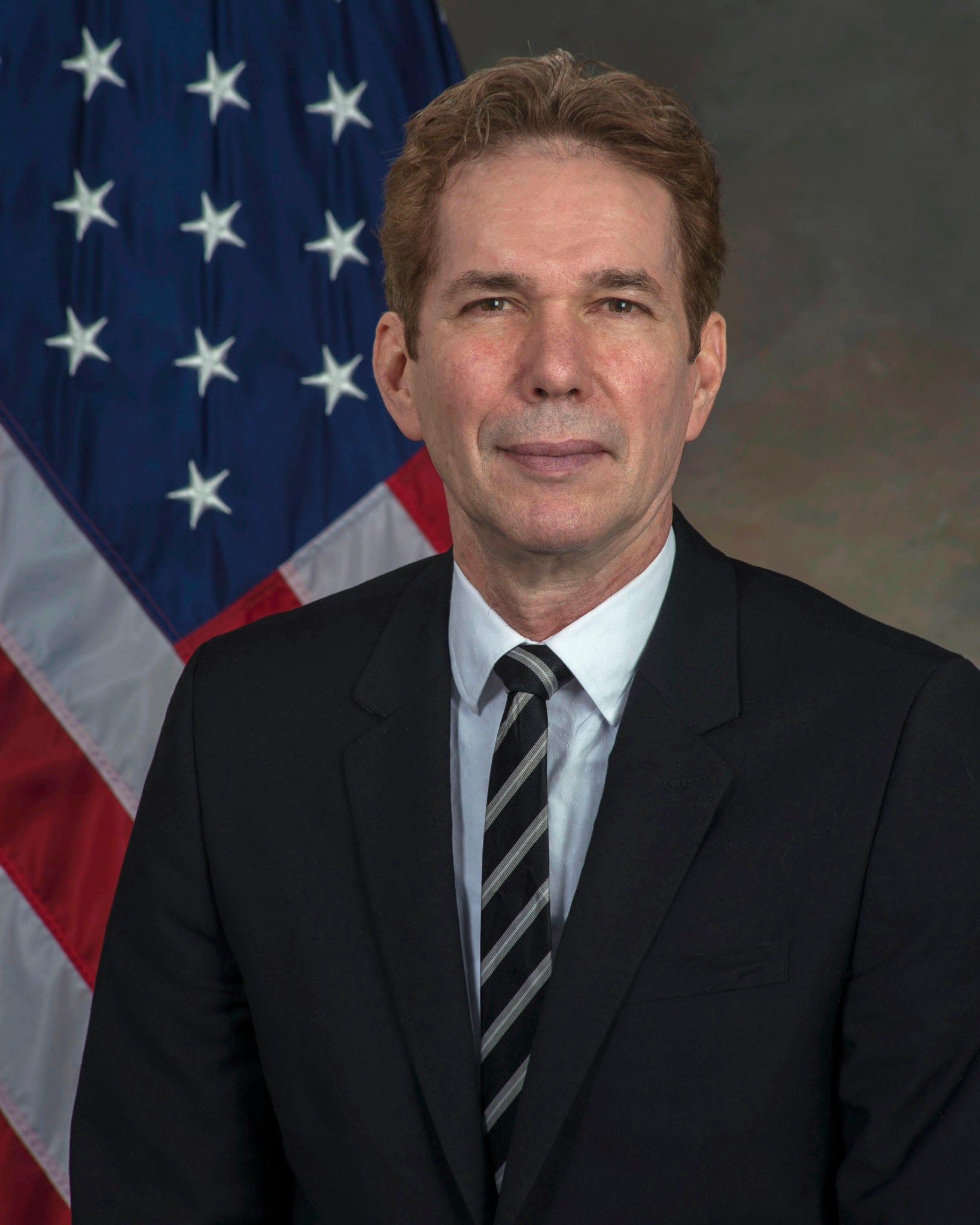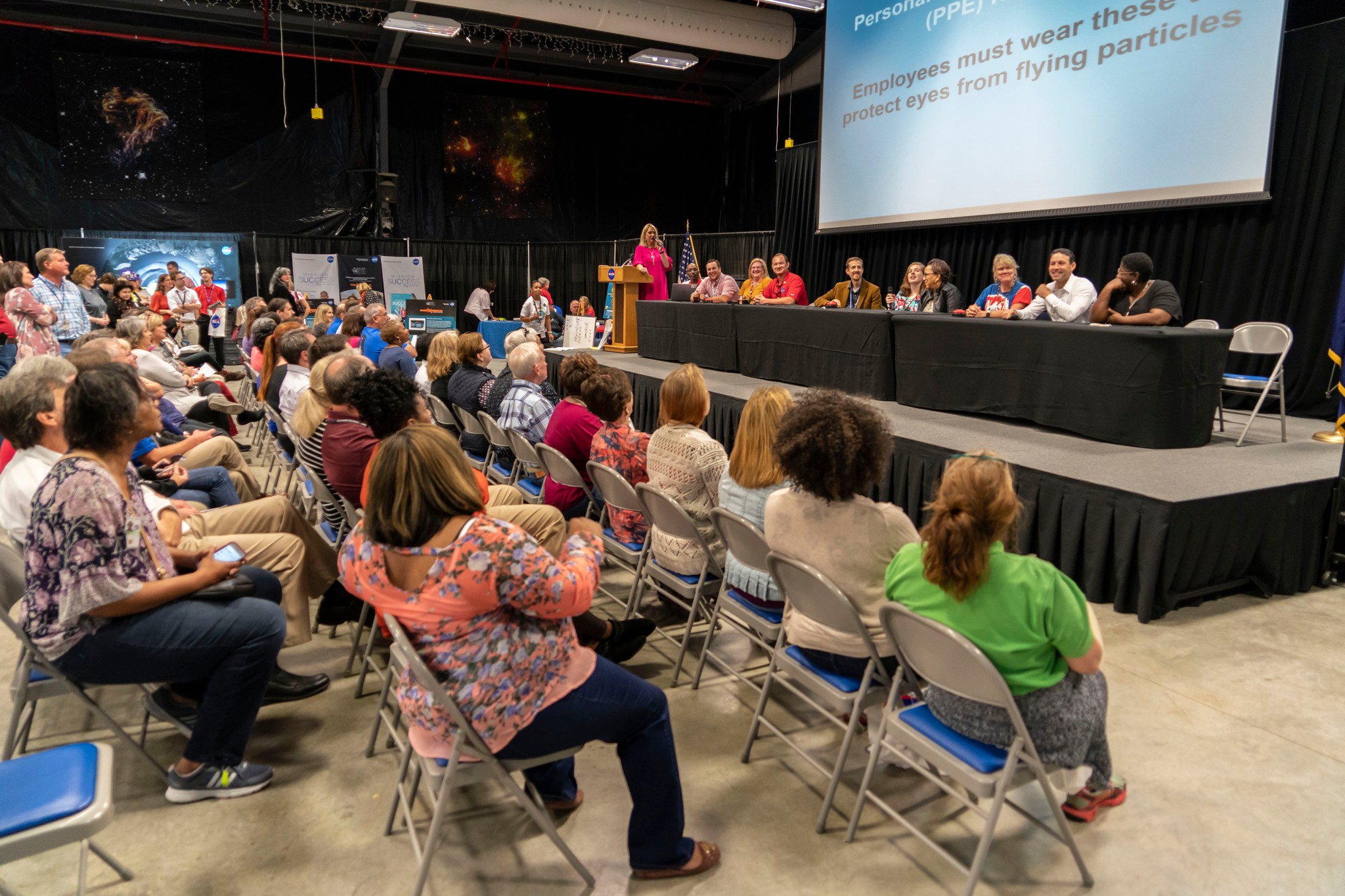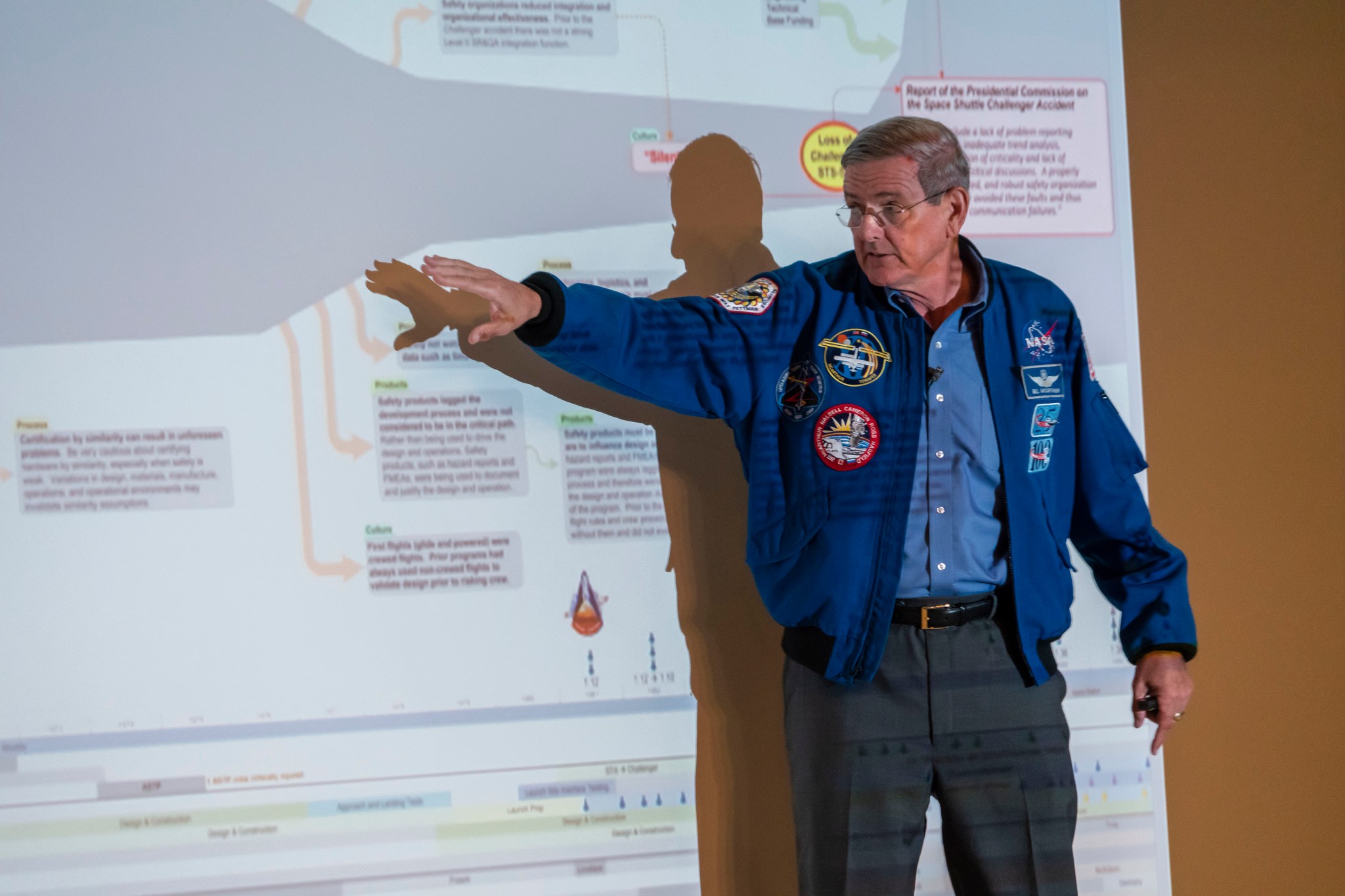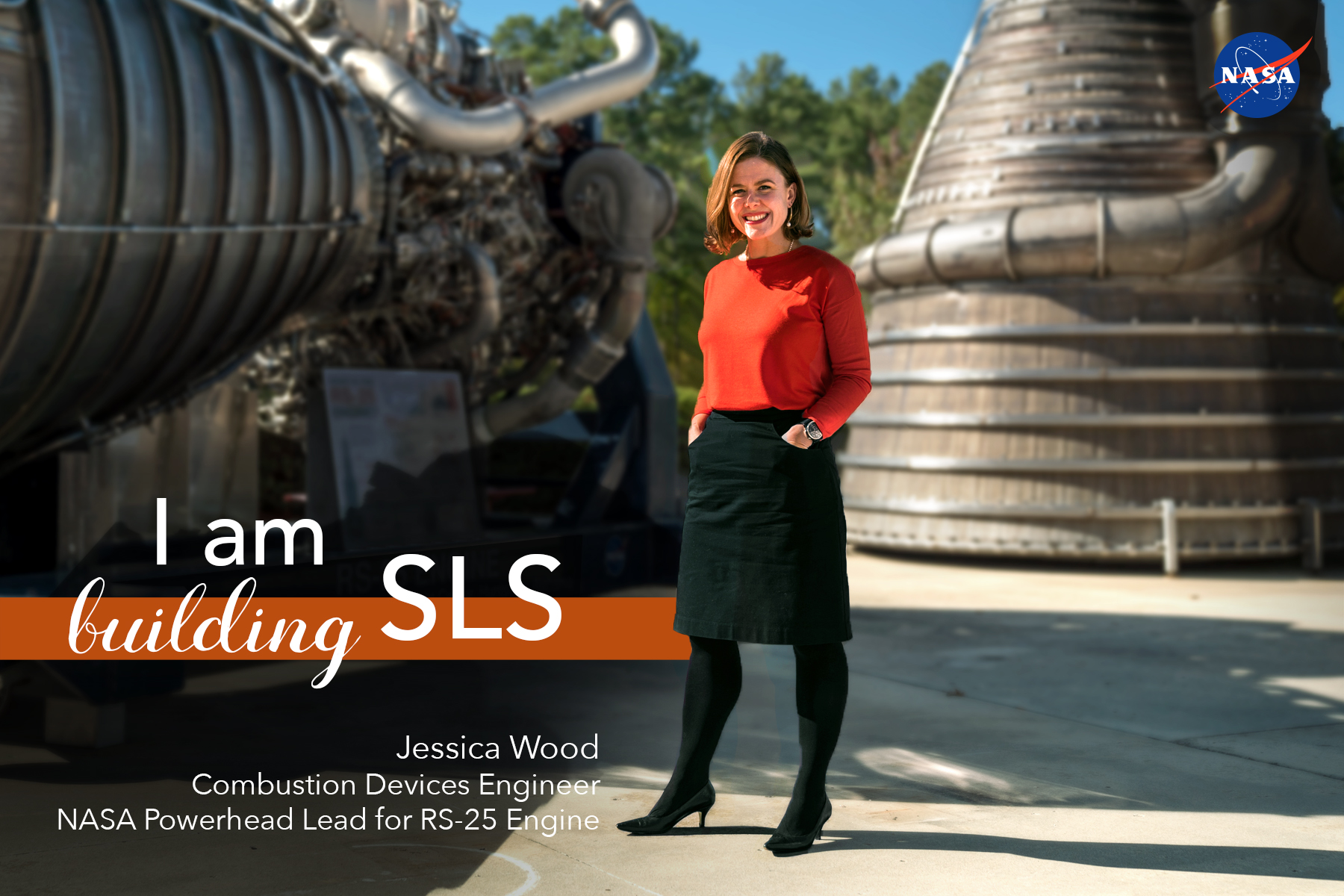In This Week’s Star
- Paul McConnaughey Named Marshall Space Flight Center Deputy Director
- Intertank for NASA’s New Rocket Readied for Final Assembly
- Marshall Teams Bring Home Game Changing Development Awards
- Marshall Holds International Space Station All-Hands Meeting
- NASA’s Steve Shih Leads Mentoring Discussion at Marshall
- Marshall Team Members Play it Safe on Halloween
- SLS Engineer ‘Just Keeps Swimming’
- NASA Conducts Halloween RS-25 Engine Test
- NASA and Redstone Arsenal Leaders Thank Marshall Veterans
- This Week in NASA History: S-II-F/D Stage Arrived at Marshall – Nov. 11, 1966
- Three Missions Managed by Marshall Team Highlighted on ‘This Week @NASA’
Paul McConnaughey Named Marshall Space Flight Center Deputy Director
Paul McConnaughey has been appointed deputy director of NASA’s Marshall Space Flight by Marshall Director Jody Singer.
McConnaughey will share responsibility for leading one of NASA’s largest field installations, with almost 6,000 civil service and contractor personnel, an annual budget of approximately $2.8 billion, and a broad spectrum of human spaceflight, science and technology development.
“Paul brings a wealth of knowledge to the position,” Singer said. “His technical expertise and knowledge of Marshall’s operations will be invaluable as we continue to advance space exploration here at Marshall. I am excited to continue this journey with him as deputy director.”
Since 2015, McConnaughey has served as associate director, technical, in Marshall’s Office of the Center Director, responsible for ensuring the performance of Marshall’s programs and technical activities, with respect to cost, schedule and mission success.
He joined Marshall in 1986 as a mathematician in the Systems Dynamics Laboratory. Over his 32-year career at NASA, he has served in a variety of leadership capacities. He completed the Senior Executive Service Candidate Development Program in 1999 and was appointed to the Senior Executive Service — the personnel system covering top managerial positions in federal agencies — in 2000 as director of the Engineering Directorate’s Structures, Mechanical and Thermal Department. In 2004, he was named deputy manager of the Spacecraft and Vehicle Systems Department, directing the research, development, design and integration of state-of-the-art spacecraft and vehicle systems and exploration missions. From 2007 to 2011, he was Marshall’s chief engineer overseeing Marshall’s Technical Excellence initiative.
McConnaughey holds a Bachelor of Science degree from Oregon State University in Corvallis, and a Master of Science degree and doctorate from Cornell University in Ithaca, New York. For his service to NASA, he has received three NASA Exceptional Service Medals, a NASA Outstanding Leadership Medal, and a Center Director’s Commendation. In 2011, McConnaughey received the Presidential Rank Award for Meritorious Executive.
McConnaughey and his wife, Angie Jackman, reside in Huntsville. He has three daughters.
Intertank for NASA’s New Rocket Readied for Final Assembly
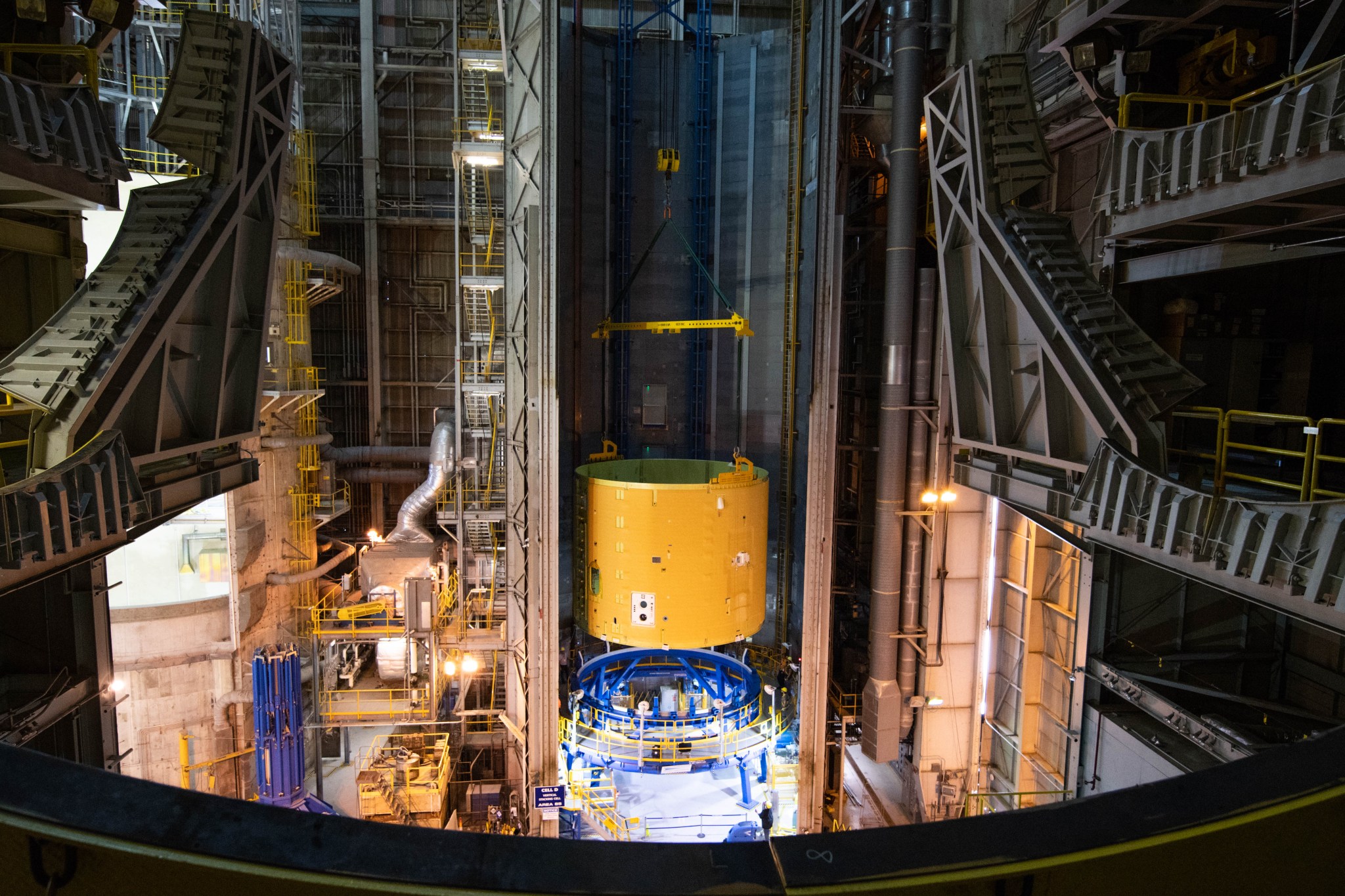
Technicians lifted the intertank for NASA’s deep space rocket, the Space Launch System, into a vertical stacking area at NASA’s Michoud Assembly Facility. Here, engineers will join it with two other large structures to form the top half of the 212-foot-tall core stage that will be flown on Exploration Mission-1, the first flight of SLS and the Orion spacecraft. The intertank, which holds some of the avionics that help control the rocket, will be bolted to the propellant tank that will hold 196,000 pounds of liquid oxygen. Later the forward skirt, which houses the flight computers and more avionics, will be put on the very top of the stack. This operation, called “the forward join,” will complete the assembly of the top of the core stage. (NASA/Jude Guidry)
Marshall Teams Bring Home Game Changing Development Awards
By Will Bryan
Engineers and team members at NASA’s Marshall Space Flight Center are accustomed to working with large pieces of hardware. Recently at the NASA Game Changing Development Program’s annual review at the Ohio Aerospace Institute near NASA’s Glenn Research Center, Marshall team members brought back two more pieces of “hardware”: the Project Manager of the Year Award and the Most Enduring Project of the Year Award.
The Project Manager of the Year Award was presented to Sonny Mitchell, who leads the Nuclear Thermal Propulsion project at Marshall. The award is given to the project manager whose exceptional passion, project management practices and organizational leadership resulted in superior performance of a project throughout the year.

Mitchell gave the credit to his team: “To me, the award is really for the entire Nuclear Thermal Propulsion team and all the great work they’ve done over the past few years. It is a recognition by Game Changing of all the good work the team has done,” he said.
Mitchell began working on the project in 2014 as program manager and continued that role when it was moved to the Game Changing Development Program in 2016. The program is one of many projects he has worked during his three-decade career at Marshall. Other projects and programs he’s worked span the gamut of Marshall expertise, including dynamic testing for rockets and spacecraft; training astronauts for Spacelab; working on science experiments for the International Space Station; and working on the Gamma-ray Burst Monitor instrument on NASA’s Fermi Gamma-ray Space Telescope.
The other award received by Marshall is the Most Enduring Project of the Year Award, presented to the Low-Cost Upper Stage Program, also known as LCUSP, led by program manager John Fikes. LCUSP is a multi-center project featuring team members from Marshall, Glenn and NASA’s Langley Research Center.
“LCUSP was a NASA-industry effort to develop and demonstrate additive manufacturing processes to produce rocket propulsion components in less time and at a lower cost than conventional manufacturing methods,” said Fikes.
The program received the award for its “enduring commitments to their research and the overall NASA mission by overcoming significant challenges.” The program is part of the Advanced Manufacturing Technologies portfolio in Game Changing Development.
“During LCUSP we had our share of ups and downs; challenges and successes,” said Fikes. “But as a team — from Marshall, Glenn and Langley — we did not dwell on the challenges but worked together to rapidly address the hurdles and focus on forward planning to overcome them.”
In 2018, the team successfully tested the components to 100 percent of the design requirements — a significant milestone. To date, the team has eight additively manufactured chambers with over 7,000 seconds of hot-fire test time on them. In 2019, the technology moves to a new program called RAMPT — Rapid Analysis and Manufacturing Propulsion Technology — that will advance the development of additively manufactured, large-scale engines and composite structures.
“I have enjoyed the opportunity to work through the challenges with an exceptional team from across the agency and to see our technology being infused into commercial industry and private space, as well as NASA projects,” said Chris Protz, technical lead for LCUSP. “Everyone on the project performed at their highest potential, and it was through the mutual support that we were able to endure our ups and downs.”
Marshall is known for enabling space exploration. Whether leaving Earth’s surface or traveling from one planet to another, team members at Marshall develop technologies to help change the game of exploring the cosmos.
NASA’s Game Changing Development Program is managed at NASA Headquarters and handles a portfolio of more than two dozen programs and projects.
Bryan, an ASRC Federal/Analytical Services employee, supports the Office of Strategic Analysis & Communications.
Marshall Holds International Space Station All-Hands Meeting
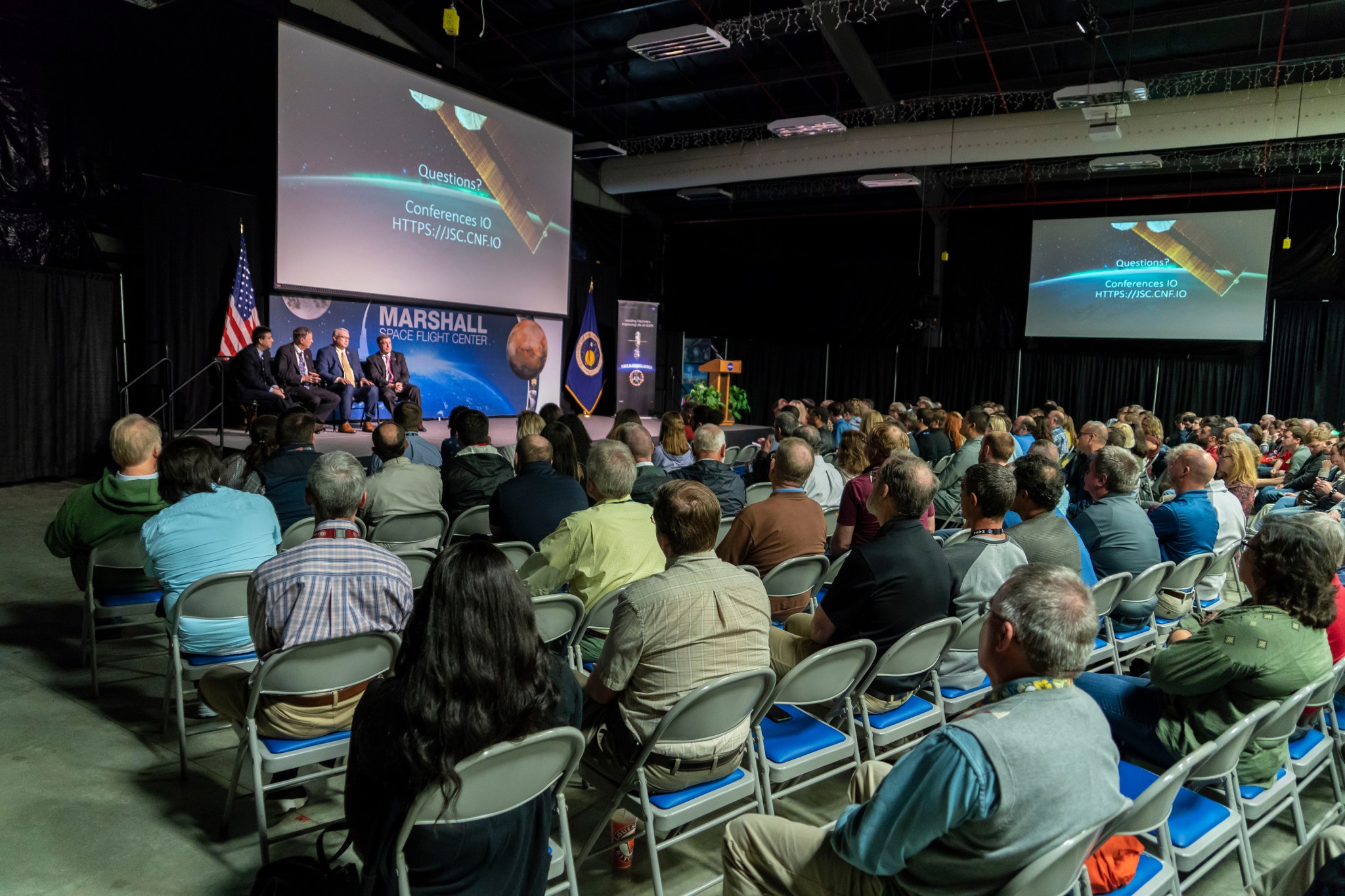
NASA employees and contractors supporting the International Space Station gathered at the agency’s Marshall Space Flight Center Nov. 1 for an all-hands meeting with Kirk Shireman, manager of NASA’s ISS Program; and Daryl Woods, ISS Payload Operations cost account manager in Marshall’s Human Exploration Development and Operations Office. It was the first time the annual meeting was held outside NASA’s Johnson Space Center, which serves as the home of mission control for space station operations and missions. The Payload Operations Integration Center at Marshall is the primary space station science command post, coordinating all U.S., European, Japanese and Canadian scientific and commercial experiments on the station, synchronizing payload activities of international partners, and directing communications between station crewmembers and researchers around the world with onboard experiments.
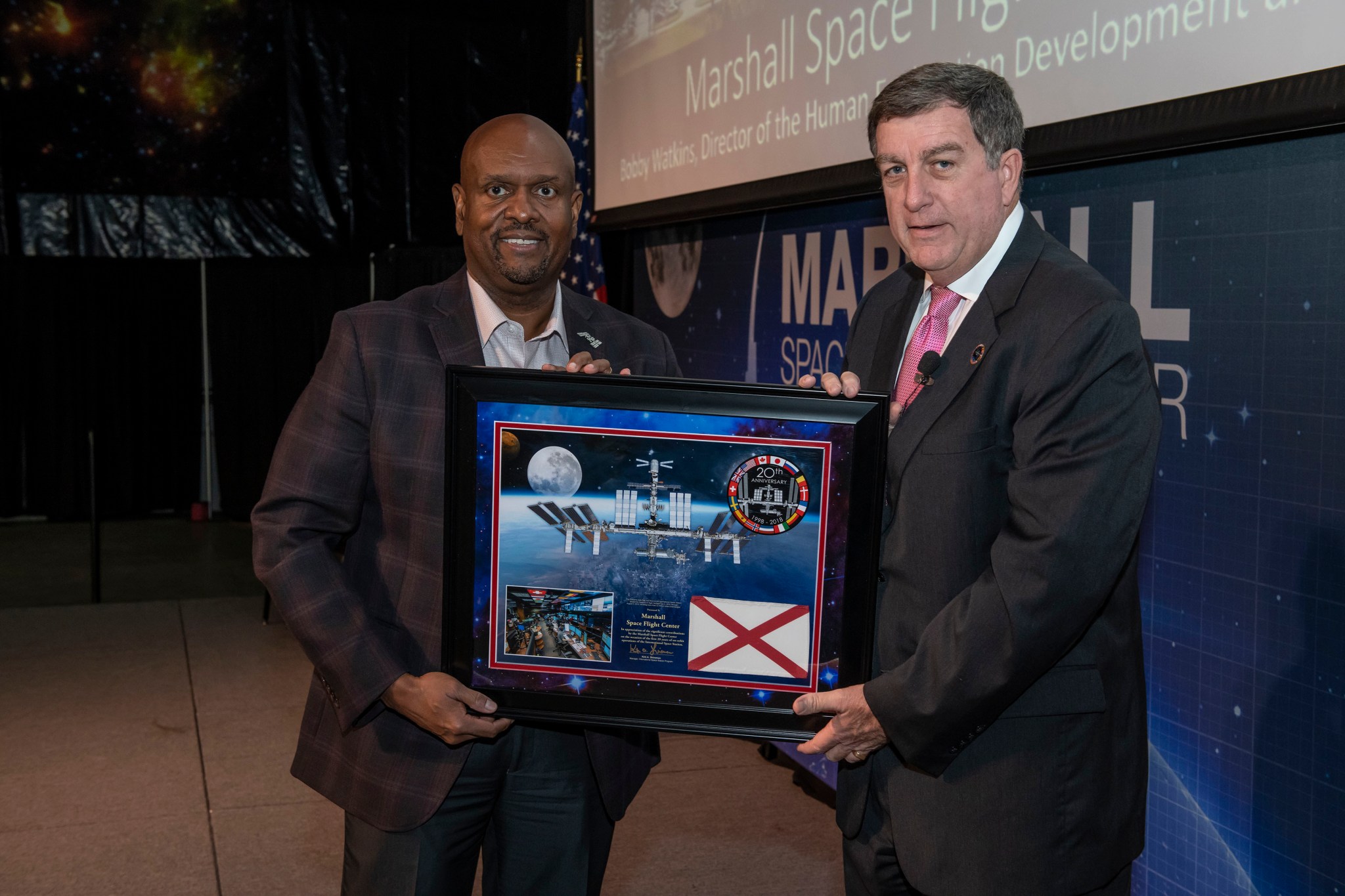
Kirk Shireman, right, manager of NASA’s ISS Program, presents a plaque to Bobby Watkins, director of Marshall’s Human Exploration Development and Operations Office, at the Nov. 1 all-hands meeting with space station personnel. The plaque recognizes the significant contributions by Marshall to the space station on the 20th anniversary of the launch of the space station’s first module. On Nov. 20, 1998, the Zarya cargo module was launched aboard a Russian rocket and placed into orbit, beginning the era of station assembly. (NASA/Fred Deaton)
NASA’s Steve Shih Leads Mentoring Discussion at Marshall
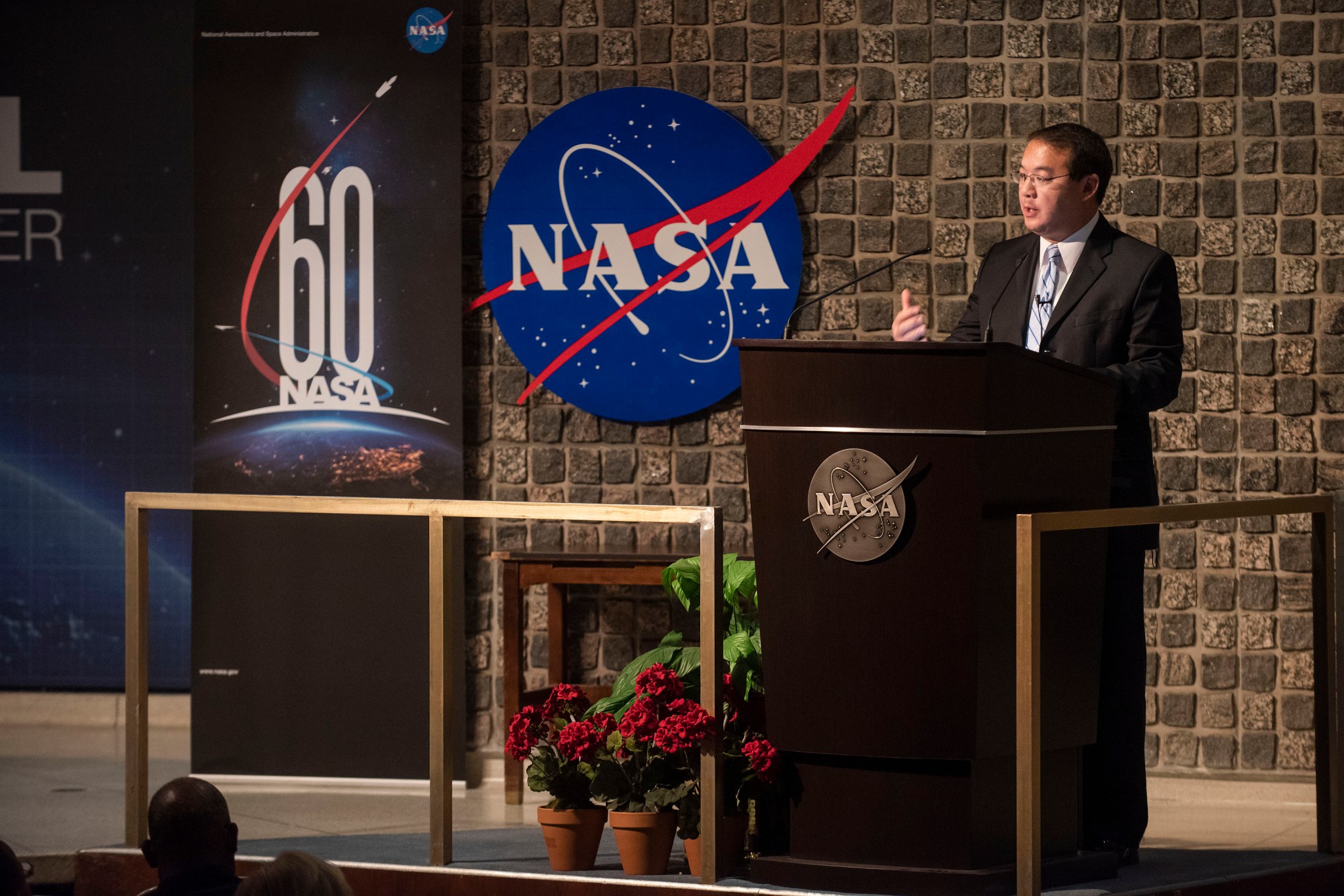
Steve Shih, NASA associate administrator for Diversity & Equal Opportunity, addresses NASA team members during a Nov. 6 mentoring event at the agency’s Marshall Space Flight Center. Shih and mentors from across the center discussed ways for team members on both sides of the mentoring equation to get the most out of the experience. Marshall’s Human Resources Office sponsored the activity, and Marshall Associate Director Steve Miley served as emcee. To learn more about mentor opportunities at Marshall, contact Renea Scoble, Marshall human resources specialist. (NASA/Charles Beason)
Marshall Team Members Play it Safe on Halloween
By Jonathan Deal
NASA Marshall Space Flight Center team members paused to recognize the importance of safety Oct. 31 as part of the center’s 2018 Safety Day. Focusing on the theme, “No One Gets Hurt – Work, Home, Space and Beyond,” Safety Day featured activities and classes concentrating on safety across the center.
“Safety Day is an important time to renew our focus on our personal safety, the safety of our team and the safety of the environment we work in,” said Marshall Center Director Jody Singer at the kickoff event in Morris Auditorium. “Having a safe place to work is critical to having happy and healthy employees as well as making our lives better. We have to have that to deliver on our missions and we must strive to become an accident- and injury-free workplace.”
The event kicked off with an address from former NASA astronaut Bill McArthur, followed by a question-and-answer panel discussion. McArthur, director of Safety and Mission Assurance at NASA’s Johnson Space Center before his retirement in July 2017, talked about safety in the workplace and lessons learned from his time as an astronaut during the Space Shuttle Program.
“Working safely is a behavior dependent on leadership, peer pressure and culture,” said McArthur. “If everyone around you has a strong safety culture, you will too.”
As part of the day’s activities, Marshall held a celebration for achieving more than one year with no lost time or days away due to injury or illness — a record for the center.
“We’ve worked 470 days without a lost-time injury — about 14 million hours and counting. It’s no small feat to be able to accomplish this when you think about all the things that we do,” said Singer. “When you think about the 6,000 employees in our workforce, it is really a proud moment to think about how much effort and focus we put on safety and the importance of it.”
Other highlights from Safety Day included an update on NASA’s Space Launch System concentrating on flight safety, a “Home Fire Prevention” class and various physical fitness classes offered at the Marshall Wellness Center throughout the day.
Deal, an ASRC Federal/Analytical Services employee and Marshall Star Editor, supports Marshall’s Office of Strategic Analysis & Communications.
SLS Engineer ‘Just Keeps Swimming’
Meet Jessica Wood, combustion device engineer and NASA powerhead lead for the RS-25 engine that will power NASA’s Space Launch System rocket.
My NASA journey began with my grandmother who worked for the National Advisory Committee for Aeronautics in the 1940s before it became NASA. She worked as a computer at Langley Research Center for the engineer who became the first flight director for the agency’s Johnson Space Center. I am continuing her legacy by playing a part in making history with the SLS rocket.
The spirit of exploration runs deep in my work life and personal life. I serve as the NASA combustion devices powerhead lead for the RS-25 engine at NASA’s Marshall Space Flight Center. Four RS-25 engines, built by Aerojet Rocketdyne in Canogo Park, California, will power the first flight of the SLS rocket and Orion spacecraft during Exploration Mission-1 (EM-1), as well as future missions.
My passion for exploration spills over from deep space to open-water swimming. I have conquered swims like Lake Tahoe the “long way” and the “Bridge to Bridge” 10K swim from the Golden Gate Bridge to Bay Bridge in San Francisco. Swimming the 21.3 mile length of Lake Tahoe was no easy feat, but I focused on 30 minute increments and ultimately finished in 13 hours, 21 minutes. Building rocket engines is much like a long swim in that you have to take it one step, or stroke, at a time to prevent getting overwhelmed by the big picture.
Aerojet Rocketdyne has started manufacturing brand new engines for SLS, and the powerhead is an integral part of this restart effort. The powerhead is the “backbone” of the engine, housing critical parts such as the hot gas manifold, main injector, heat exchanger and preburners. Located directly above the main combustion chamber, the powerhead is difficult to see in an assembled RS-25 because it is at the very center of the engine.
In addition to supporting these production engines, NASA and Aerojet Rocketdyne are currently upgrading the engine design to cut costs by 50 percent and reduce schedule by using advanced manufacturing processes. The team is developing innovative methods to manufacture parts including the powerhead, main combustion chamber and nozzle. This requires a multidisciplinary engineering, analysis and mission support team. Implementing these new designs includes partnership not only between NASA and Aerojet Rocketdyne, but also large and small manufacturers across the United States. The powerhead is a complex piece of hardware made up of thousands of individual pieces, so we look at the big picture to make sure we are both building it as efficiently as possible and ensuring that it will work just as well with parts made a new way.
I attended Georgia Institute of Technology in Atlanta, and received a Bachelor of Science in industrial design. After starting my first job at Marshall, I continued my education by earning a second Bachelor of Science in mechanical engineering from the University of Alabama in Huntsville while working on cryogenic fluid management technology at Marshall.
Whether I am helping build parts of a rocket that will send astronauts to the Moon or completing a long-distance swim — I often visit a quote from Disney’s Finding Nemo: “Just keep swimming.”
I imagine the day SLS launches will feel a lot like the final stroke of a journey in the water. I’ll take a deep breath and smile at what humankind has accomplished by achieving greater things than our minds could ever comprehend.
NASA Conducts Halloween RS-25 Engine Test
NASA delivered a treat with a full-duration RS-25 engine test Oct. 31, and the shake, rattle and roar of the hot fire kept away any eerie creaks and frightful sounds the Halloween day might have had to offer.
A team of NASA, Aerojet Rocketdyne and Syncom Space Services operators conducted the 500-second RS-25 test on the A-1 Test Stand at Stennis Space Center, the fifth hot fire in an engine test series that began in mid-August. The test marked an acceptance hot fire of another RS-25 engine controller for use on a future flight of NASA’s new Space Launch System (SLS) rocket, which is being built now to carry humans deeper into space than ever before.
The new flight controller serves as the RS-25 “brain,” helping the engine communicate with the rocket and controlling engine operation and internal health diagnostics. The recent RS-25 test series also features a 3D-printed pogo accumulator, used to dampen pressure oscillations that can cause flight instability, and an innovative main combustion chamber, fabricated using a new hot isostatic pressing bonding technique that saves considerable time and money.
NASA has been testing RS-25 engines at Stennis since 2015 to ensure they will perform as needed for SLS, which will be the most powerful rocket in the world. Four RS-25 engines, firing simultaneously, will provide a combined 2 million pounds of thrust to help launch the new rocket. The engines will fire in conjunction with a pair of solid rocket boosters; altogether, SLS will launch with more than 8 million pounds of thrust.
The RS-25 engines to be used on initial SLS missions are former space shuttle main engines, modified to provide additional power. Through the shuttle years, the engines were modified to provide additional thrust up to 109 percent of the original designated level. SLS will also evolve to a larger, more powerful rocket, and engines are being modified again to operate at 111 percent of their original power level for additional performance. In addition to its RS-25 hot fires, NASA is preparing to test the core stage for the first SLS mission on the B-2 Test Stand at Stennis. The test will involve installing the flight core stage on the renovated stand and firing its four RS-25 engines simultaneously, like during an actual launch.
RS-25 engines are important for powering the SLS as NASA leads a return to the Moon through an innovative and sustainable program of exploration to expand human presence into the solar system. Beginning with Exploration Mission-1, SLS and Orion will demonstrate the critical backbone capabilities that will carry humans to the Moon and farther into space than ever before on a variety of missions with increasing complexity. SLS’s unprecedented power and volume will also carry the large pieces of hardware needed to build the Gateway and other long-term infrastructure at the Moon and later, for human missions to Mars.
Aerojet Rocketdyne is the RS-25 engine prime contractor. Syncom Space Services is the prime contractor for Stennis facilities and operations.
NASA and Redstone Arsenal Leaders Thank Marshall Veterans
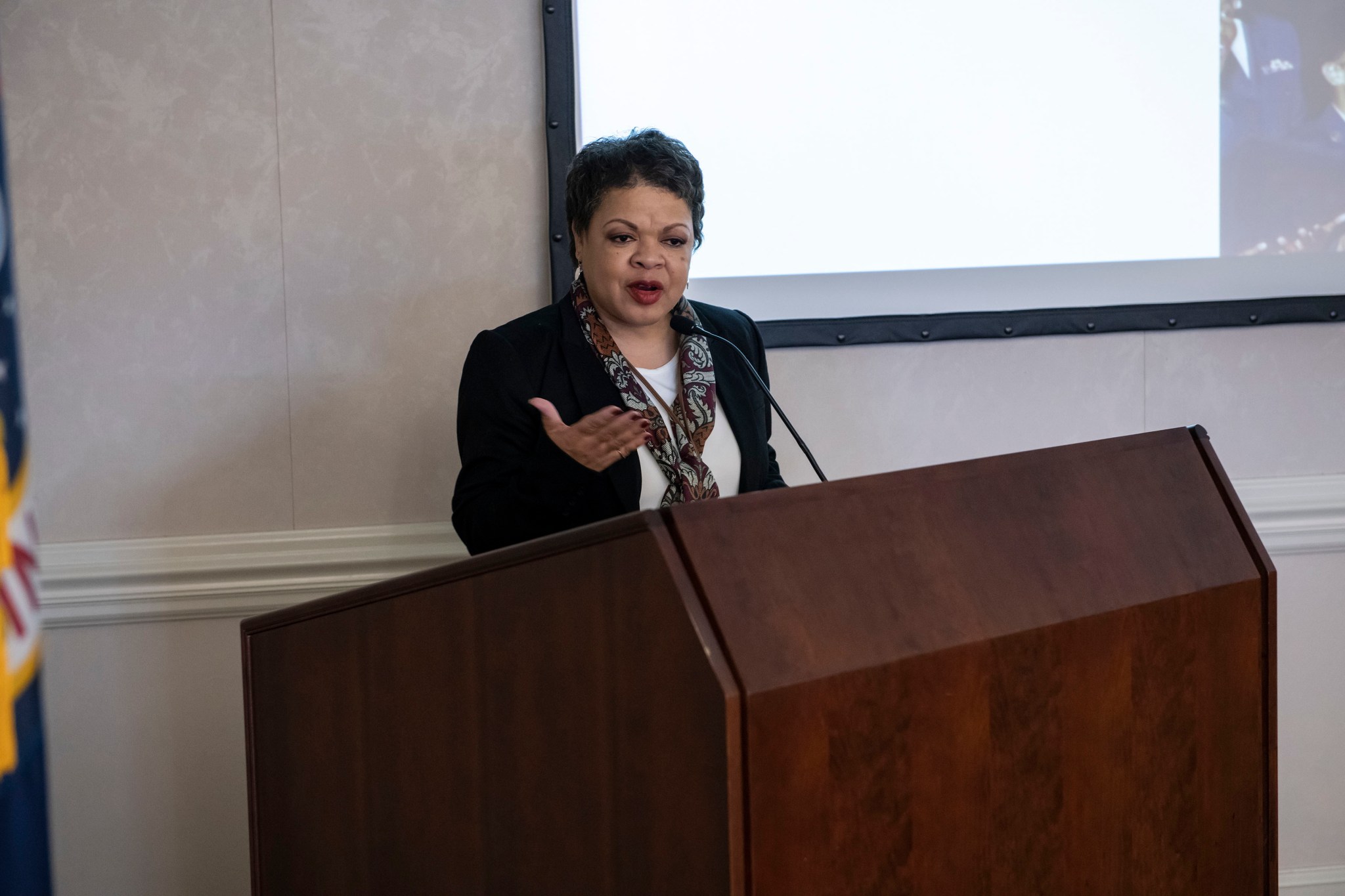
Janet Sellers, director of diversity and analytics in the Office of Diversity and Equal Opportunity at NASA Headquarters, speaks to veterans at NASA Marshall Space Flight Center’s Veteran’s Meet and Greet program Nov. 6. Marshall’s annual Veterans Day program recognizes the service and dedication of veterans at Marshall and thanks them for their continued service to their country. (Credit: NASA/Fred Deaton)
Col. Kelsey Smith, Redstone Arsenal Garrison Commander, delivers remarks to honor veterans at Marshall’s Veteran’s Meet and Greet program Nov. 6. A slideshow, in the background, highlights the activities of Marshall veterans. (Credit: NASA/Fred Deaton)
This Week in NASA History: S-II-F/D Stage Arrived at Marshall – Nov. 11, 1966
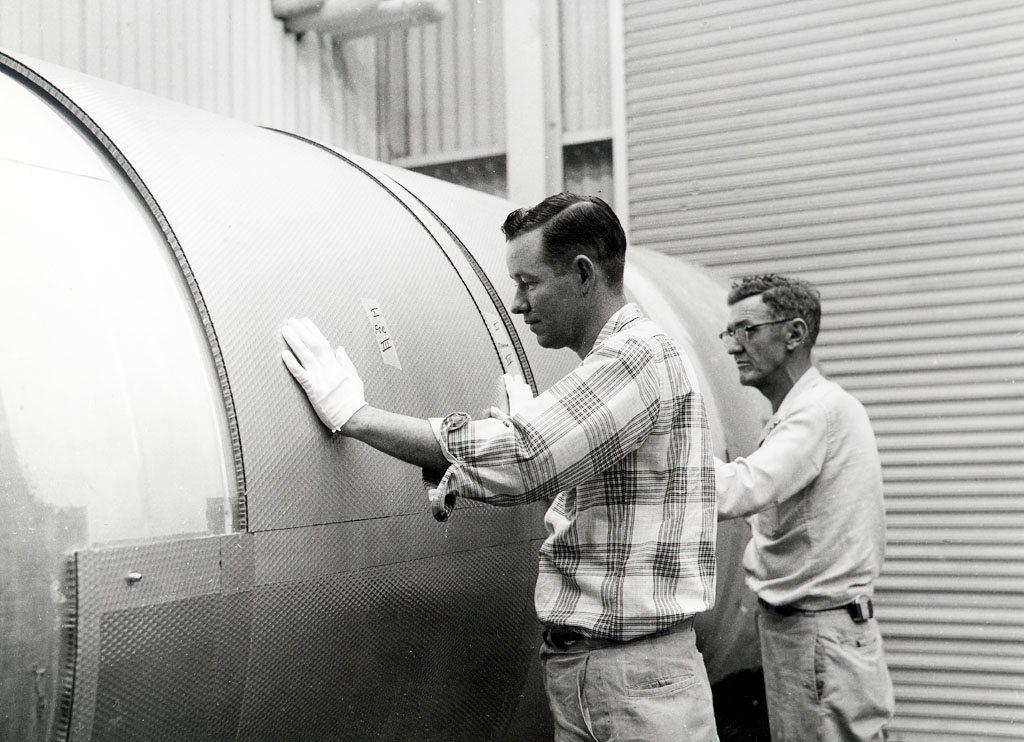
This week in 1966, the second stage Facilities Checkout/Dynamic Test Stage, or the S-II-F/D, arrived at NASA’s Marshall Space Flight Center. This stage of the Saturn V launch vehicle was not meant to fly, but was used for ground testing prior to flight tests. The S-II stage of the rocket employed five J-2 engines, which were capable of producing 225,000 pounds of thrust. Here, two technicians apply insulation to the outer surface of the S-II stage. Today, Marshall is developing NASA’s Space Launch System, the most powerful rocket ever built, capable of sending astronauts to the Moon, Mars and deeper into space than ever before. The NASA History Program is responsible for generating, disseminating, and preserving NASA’s remarkable history and providing a comprehensive understanding of the institutional, cultural, social, political, economic, technological and scientific aspects of NASA’s activities in aeronautics and space. For more pictures like this one and to connect to NASA’s history, visit the Marshall History Program’s webpage. (NASA)
Three Missions Managed by Marshall Team Highlighted on ‘This Week @NASA’
Three missions managed by NASA’s Discovery Program at Marshall Space Flight Center are featured in “This Week @NASA,” a weekly video program broadcast nationwide on NASA-TV and posted online.
After nine years in deep space, NASA is ending the science operations of the agency’s Kepler space telescope. Data collected by Kepler have helped scientists discover there are more planets than stars in the Milky Way galaxy. The telescope has discovered more than 2,600 planets during its mission, many of which could be promising places for life. Kepler will be retired into a safe orbit away from Earth.
NASA’s Dawn spacecraft, which became the first mission to go into orbit around two destinations beyond Earth, missed several communications sessions with the agency’s Deep Space Network and mission managers ended the historic mission — concluding that the spacecraft has finally run out of the fuel it uses to orient itself in space. Launched 11 years ago, Dawn visited the two largest objects in the main asteroid belt — Vesta and Ceres, the dwarf planet it is currently orbiting. Dawn is expected to remain in orbit around Ceres for at least 20 years.
Mission managers previewed the InSight mission to Mars during an Oct. 31 briefing at NASA Headquarters. The InSight lander is scheduled to touch down on the Red Planet on Nov. 26. Its suite of instruments will study marsquakes and other activity deep below the Martian surface to help us better understand how all rocky planetary bodies formed — including Earth and its Moon.
Kepler, Dawn and InSight are all projects of the agency’s Science Mission Directorate’s Discovery Program, managed by Marshall.
View this and previous episodes at “This Week @NASA” on NASA’s YouTube page.




























